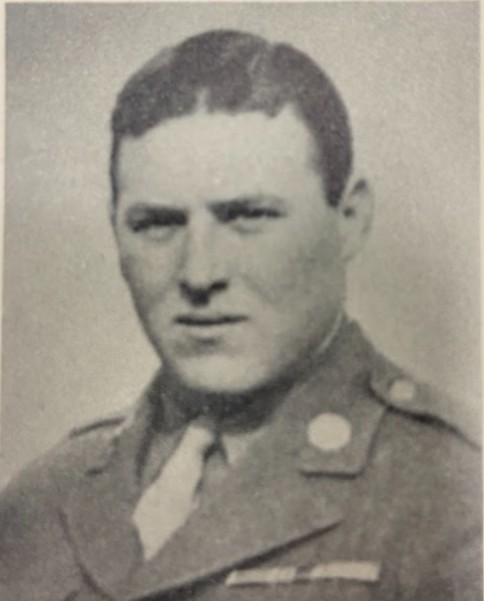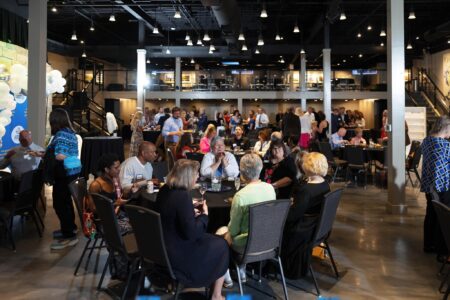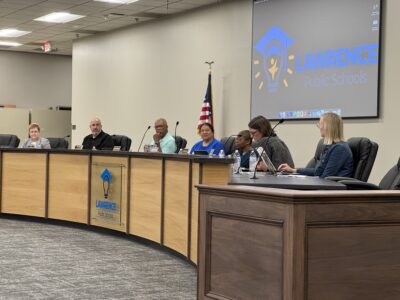Bringing a soldier’s story home: Bishop Seabury student-teacher team honors local WWII veteran in Normandy

photo by: Contributed
Benjamin Patterson and Sonja Czarnecki, a student-teacher duo from Bishop Seabury Academy, visited Normandy, France to honor a World War II veteran from Lawrence.
When Benjamin Patterson stood at the grave of a 23-year-old World War II combat engineer from North Lawrence, he didn’t just see a name etched in white marble — he saw a life he had spent months uncovering.
Since January, Patterson, a rising senior, and Sonja Czarnecki, a social studies teacher at Bishop Seabury Academy, have been researching World War II veteran Carl Spitzer, and their research culminated in a biography that brought his story home again, 81 years after his death.
They were both chosen to participate in the 2025 Albert H. Small Normandy Institute along with other student-teacher teams. The institute takes high school students through an intensive program to learn about the D-Day Campaign of 1944.
The campaign – also known as Operation Overlord – was the massive Allied invasion of German-occupied Western Europe during World War II. It began on June 6, 1944, with the Normandy landings, one of the largest military assaults in history, and marked a turning point in the war.
The Institute gives the teams the chance to travel to Washington, D.C., and to Normandy in France to walk in the footsteps of a lot of this history. Czarnecki said the institute had received close to 70 applications for this year, but only 15 were awarded.
As a part of joining the institute, the students explore a selected topic related to the Normandy campaign and conduct in-depth research on the life of a soldier buried at the Normandy American Cemetery in Colleville-sur-Mer, France. At the cemetery, students honor the soldier by presenting their researched biography at the individual’s gravesite.
They also have the opportunity to walk the beaches and battlefields of Normandy, explore the fortifications of the Atlantic Wall and visit historical and cultural sites in Paris. Both Patterson and Czarnecki returned from their trip to Normandy on June 29 after visiting for a week.
Prior to making the trip to France, they traveled to D.C. to visit George Washington University’s campus and hear lectures by faculty members, visit Arlington National Cemetery, conduct research at the National Archives and more.
The experience inspires students to take initiative and explore a soldier’s life in great detail.
“I had to do very little orienting in the right direction, then he took off and ran with it in a much deeper way than I probably would have done on my own,” Czarnecki said.

photo by: Contributed
Carl Spitzer
Who was Carl Spitzer?
In his early childhood, Spitzer and his family relocated to North Lawrence, and by 1930, the Spitzers were renting a property at 345 Lyon St. By 1940, they owned a home at nearby 342 Lincoln St. According to past coverage by the Journal-World, in 1938, Spitzer got into a car crash with another driver, Earl Hope, at the North Lawrence intersection of North Eighth and Maple streets, where Spitzer’s Ford coupe was damaged.
Spitzer had registered for the Selective Service System on February 15, 1942, and was drafted into the military shortly after the U.S. entered World War II. He underwent training at Fort Bragg and Fort Leonard before being deployed to North Africa, where he acquired the skills to join the 15th Engineering Battalion, an auxiliary to the 9th Infantry Division. He learned how to remove mines, drive military vehicles and build bridges.
On Aug. 11, 1943, Spitzer was injured by a mine explosion while performing his duties and spent nearly two months in the hospital before returning to his unit. He received a Purple Heart for this.
The 9th Infantry Division played a crucial role in the Normandy invasion, focusing on securing the Cotentin Peninsula and capturing Cherbourg. Their efforts involved extensive engineering work to support advancing troops. The capture of Cherbourg marked a significant victory for the division, and it led to the surrender of thousands of German soldiers.
Spitzer was killed in action on June 29, 1944, while performing his duties as an engineer. He was likely killed by an artillery shell or sniper fire while working on infrastructure. He was just 23 years old.
The 9th Infantry Division continued to play a vital role in liberating Europe, such as in the liberation of Belgium and crossing into Germany. Spitzer was initially buried in Sainte Mere Eglise Cemetery #2, a temporary burial place for fallen soldiers in the Cotentin Peninsula, on June 30 before being moved to Normandy American Cemetery.

photo by: Contributed
Benjamin Patterson puts sand from Omaha Beach on Carl Spitzer’s gravesite at the Normandy American Cemetery in Colleville-sur-Mer, France.
‘An individual perspective’
Spitzer was one of 9,388 American military personnel buried in the cemetery, which is primarily for those who died during the D-Day landings and subsequent operations in World War II. While there were so many soldiers to choose from, the team from Bishop Seabury narrowed their choice down to Spitzer.
During the first part of the program in Washington D.C., Czarnecki said the staff at the National Archives was helpful in preparing resources that would aid in their research on Spitzer.
“We had just went through pages and pages of material,” Czarnecki said. “… Ben had a chance to do real hands-on archival research using the primary resources that are completely unique and only exist in these boxes at the National Archives.”
Patterson said this was really a time where it felt like he was getting experience in the way a real researcher would. He also said that during the researching phase of putting together the biography, he had a chance to meet with Spitzer’s niece.
“She started showing us photos and talking about details that we really never would have known without her,” Patterson said. “Like, for example, she gave us a piece of information that Carl Spitzer had a fiancée before being drafted.”
While visiting Normandy, the team visited Omaha Beach, where they collected sand for a special tradition to memorialize the soldiers the student-teacher teams had chosen to research. They take sand from the beach and bring it to the gravestones and rub it into the engraving on them.
“It ends up kind of illuminating them in a way that almost looks like gold,” Patterson said. “I had never actually heard that they do that ceremony before, but it is definitely a really special and beautiful way of commemorating the soldier and kind of symbolizing that they’re still remembered.”
For many students, history can feel distant — a collection of dates, wars and political shifts. But for Patterson, the project offered something much more personal.
“You don’t really get to understand an individual perspective like this,” Patterson said. “You kind of get swept up in the general historical trends or narrative, so it is really amazing to actually get to trace the direction of the life of somebody from your own hometown and go into these massive historical events that you read about.”

photo by: Contributed
Carl Spitzer’s grave at the Normandy American Cemetery in Colleville-sur-Mer, France.







